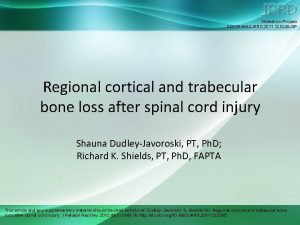Slideshow Project DOI 10 1682JRRD 2011 12 0228





- Slides: 5

Slideshow Project DOI: 10. 1682/JRRD. 2011. 12. 0228 JSP Traumatic amputation: Psychosocial adjustment of six Army women to loss of one or more limbs Janet K. Cater, Ph. D, CRC This article and any supplementary material should be cited as follows: Cater JK. Traumatic amputation: Psychosocial adjustment of six Army women to loss of one or more limbs. J Rehabil Res Dev. 2012; 49(10): XX–XX. http: //dx. doi. org/10. 1682/JRRD. 2011. 12. 0228

Slideshow Project DOI: 10. 1682/JRRD. 2011. 12. 0228 JSP • Aim – Use phenomenological approach to gain in-depth understanding of how military women adjust to traumatic limb loss. • Relevance – More than 220, 000 U. S. servicewomen fought in Iraq and Afghanistan. – Little published research on the psychosocial adjustment of women to traumatic amputation. This article and any supplementary material should be cited as follows: Cater JK. Traumatic amputation: Psychosocial adjustment of six Army women to loss of one or more limbs. J Rehabil Res Dev. 2012; 49(10): XX–XX. http: //dx. doi. org/10. 1682/JRRD. 2011. 12. 0228

Methods Slideshow Project DOI: 10. 1682/JRRD. 2011. 12. 0228 JSP • 6 female Army/Army National Guard members answered 3 open-ended questions: – “Please tell me a little bit about your background and how you came to join the military. ” – “In what ways, if any, has being injured changed your life? ” – “If you were to walk into a hospital today as a peer visitor to visit a servicewoman who had just lost a limb, what would you tell her? ” • All interviews were conducted via Skype or V-Tel and ranged from 90 to 120 min. This article and any supplementary material should be cited as follows: Cater JK. Traumatic amputation: Psychosocial adjustment of six Army women to loss of one or more limbs. J Rehabil Res Dev. 2012; 49(10): XX–XX. http: //dx. doi. org/10. 1682/JRRD. 2011. 12. 0228

Results Slideshow Project DOI: 10. 1682/JRRD. 2011. 12. 0228 JSP • Common themes: – Personal safety fears. – Body image issues. – Grief. – Loss. • Recovery in military environment promoted “kick -butt” attitude. – These servicewomen reported that positive attitude, social support, personal courage, resiliency, military training, humor, and belief their loss had meaning most influenced their recovery. This article and any supplementary material should be cited as follows: Cater JK. Traumatic amputation: Psychosocial adjustment of six Army women to loss of one or more limbs. J Rehabil Res Dev. 2012; 49(10): XX–XX. http: //dx. doi. org/10. 1682/JRRD. 2011. 12. 0228

Conclusion Slideshow Project DOI: 10. 1682/JRRD. 2011. 12. 0228 JSP • This phenomenological research study suggests that military women have increased resiliency to traumatic limb loss, particularly when they recover in military culture. • Study supports earlier research indicating social support and positive attitude were important factors in adjustment. This article and any supplementary material should be cited as follows: Cater JK. Traumatic amputation: Psychosocial adjustment of six Army women to loss of one or more limbs. J Rehabil Res Dev. 2012; 49(10): XX–XX. http: //dx. doi. org/10. 1682/JRRD. 2011. 12. 0228









